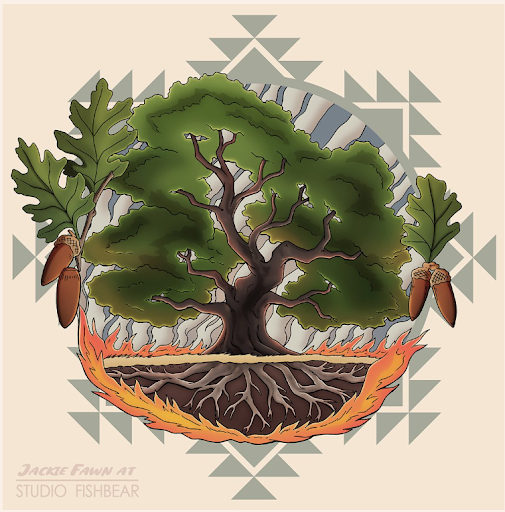Overview
Stewards of the Land - Cultural Fire

Author: Maggie Peters, (Yurok/Karuk) Educator, Traditional Basket Weaver, Cultural Preservationist, Native American Studies Model Curriculum Learning Specialist at Humboldt County Office of Education
Grades: 9-12
Suggested Amount of Time: 4 class periods of minimum of 55 minutes
Curriculum Themes
- History
- Cultural Strengths
- Law/Government
- Relationship to Place
- Cross Curricular Integration
Learning Goals
Contrast Indigenous and colonial approaches to land management, especially regarding fire suppression policies.
Comprehend how Indigenous peoples view the Earth as a gift to be cared for, versus the Western commodification of nature.
Articulate why including Indigenous knowledge in conservation and climate change efforts is essential.
Develop an appreciation for Indigenous knowledge and support Indigenous rights in environmental discussions.
Reflect on students' own relationship with nature and how societal values influence environmental stewardship.
Lesson Overview
This multi-lesson series explores the deep historical and cultural relationship California Native Tribes have with the land, focusing on how cultural burning continues to be used as a vital component of land stewardship. Students will gain insight into the significance of fire in Indigenous cultures and how it was essential for maintaining ecosystems and cultural practices. Through a combination of poems, videos, imagery, timelines and readings, the lessons will highlight the ongoing efforts by Native peoples to restore their relationship with the earth and their traditional fire practices.
The series begins with an introduction to Indigenous land stewardship, where students will learn about the role of fire in managing the land, including how fire helps regenerate important plants like acorns, which are vital to Indigenous cultures. Students will have the chance to compare and contrast the Indigenous and colonial views on land management, especially fire suppression. As the series progresses, students will understand how Historical US suppression policy has created a devastating impact that began in 1850, which criminalized Indigenous fire practices.
Students will learn about the efforts of Indigenous groups to work, such as the Karuk and Yurok Tribes, to revive cultural burning as a tool for ecological restoration. This will lead into discussions of living in balance with nature, a stark contrast to the Western concept of nature as a resource to be exploited.
By the end of the lesson series, students will understand how Indigenous practices like cultural burning can heal the land and how these practices challenge the commodification of nature prevalent in Western conservation. Ultimately, the series aims to show students why it is crucial to respect and include Indigenous voices and knowledge in addressing today’s environmental challenges.
Teacher Background
As you guide students through this lesson on Indigenous relationships with the land, take time to create a learning environment that welcomes diverse perspectives and encourages respectful dialogue. Many students may not fully grasp the environmental consequences of commodifying nature and may have little awareness of how the colonization of the United States has deliberately prevented Indigenous communities from living in balance with the land. This lesson series offers an opportunity to shift students’ understanding of nature, from something to be exploited to something to be respected and nurtured. Students may not be aware how normal it is in the United States to be unaware of the colonial disassociation with responsibility to protect the health of the Earth.
Students may come from a cultural context that values consumption, so it's crucial to create a safe space where they can explore these new perspectives without shame. The goal isn’t to make them feel guilty, but to help them see there are alternative ways of interacting with the Earth—ways that prioritize reciprocity and stewardship. Acknowledge any discomfort students may feel as they reflect about beliefs, and normalize that discomfort as part of their learning journey.
Respect for Indigenous knowledge is key. It’s important to show care for the sacredness of these teachings and to avoid treating them as a novelty or something to be appropriated. Center Indigenous voices and experiences, but don’t hold Native students to an expectation to speak for their communities.
Encourage empathy, curiosity, and compassion as students engage with complex topics like colonization, environmental degradation, and reclamation of cultural practices. Highlight the efforts of Indigenous Tribes in restoring traditional fire practices as part of environmental healing. Students should leave the lesson feeling empowered, not guilty, and inspired by the ways Indigenous wisdom can help heal the Earth.

